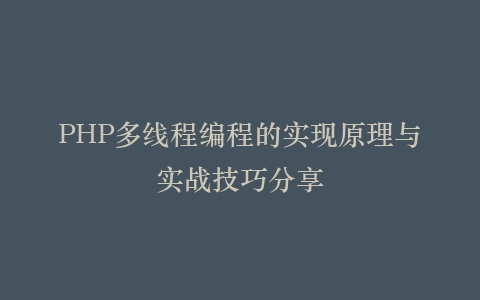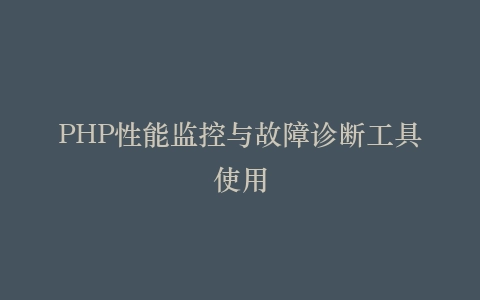
PHP接口限流与熔断机制实现:从理论到实战的完整指南
大家好,作为一名在PHP领域摸爬滚打多年的开发者,我今天想和大家聊聊接口限流与熔断机制这个看似复杂但实际非常重要的主题。记得有一次,我们项目因为一个第三方接口突然响应变慢,导致整个系统雪崩,从那以后我就深刻认识到限流和熔断的重要性。今天我就把自己在实际项目中积累的经验分享给大家。
为什么需要接口限流与熔断
在实际开发中,我们经常会遇到这样的情况:某个接口突然被大量请求冲击,或者依赖的外部服务变得不稳定。如果不加以控制,轻则系统响应变慢,重则直接宕机。限流就是控制请求的速率,而熔断则是在服务不可用时快速失败,避免资源被长时间占用。
基于Redis的令牌桶限流实现
令牌桶算法是我在项目中用得最多的限流方式,它的原理很简单:系统以固定速率向桶中添加令牌,请求需要获取令牌才能被处理。下面是我封装的一个实用类:
class RateLimiter {
private $redis;
private $key;
private $maxRequests;
private $windowSize;
public function __construct($redis, $key, $maxRequests = 100, $windowSize = 60) {
$this->redis = $redis;
$this->key = $key;
$this->maxRequests = $maxRequests;
$this->windowSize = $windowSize;
}
public function isAllowed() {
$current = time();
$windowStart = $current - $this->windowSize;
// 移除过期请求
$this->redis->zRemRangeByScore($this->key, 0, $windowStart);
// 获取当前窗口内的请求数量
$currentRequests = $this->redis->zCard($this->key);
if ($currentRequests < $this->maxRequests) {
// 添加当前请求
$this->redis->zAdd($this->key, $current, uniqid());
$this->redis->expire($this->key, $this->windowSize);
return true;
}
return false;
}
}
使用这个类时,我通常会这样调用:
$redis = new Redis();
$redis->connect('127.0.0.1', 6379);
$limiter = new RateLimiter($redis, 'api:user:login', 50, 60); // 每分钟最多50次
if (!$limiter->isAllowed()) {
throw new Exception('请求过于频繁,请稍后再试');
}
// 正常处理业务逻辑
熔断器模式的实现
熔断器就像电路中的保险丝,当服务出现问题时自动”跳闸”,避免问题扩散。我实现了一个简单的熔断器类:
class CircuitBreaker {
private $serviceName;
private $failureCount = 0;
private $lastFailureTime = 0;
private $resetTimeout = 60;
private $failureThreshold = 5;
private $state = 'CLOSED'; // CLOSED, OPEN, HALF_OPEN
public function __construct($serviceName, $failureThreshold = 5, $resetTimeout = 60) {
$this->serviceName = $serviceName;
$this->failureThreshold = $failureThreshold;
$this->resetTimeout = $resetTimeout;
}
public function attemptCall($callable) {
if ($this->state === 'OPEN') {
if (time() - $this->lastFailureTime > $this->resetTimeout) {
$this->state = 'HALF_OPEN';
} else {
throw new Exception("服务暂时不可用");
}
}
try {
$result = call_user_func($callable);
$this->onSuccess();
return $result;
} catch (Exception $e) {
$this->onFailure();
throw $e;
}
}
private function onSuccess() {
$this->failureCount = 0;
$this->state = 'CLOSED';
}
private function onFailure() {
$this->failureCount++;
$this->lastFailureTime = time();
if ($this->failureCount >= $this->failureThreshold) {
$this->state = 'OPEN';
}
}
}
实战中的踩坑经验
在实际使用中,我总结了几点重要经验:
1. 限流阈值的设置要合理:不要拍脑袋决定,要根据实际业务量和系统承载能力来设定。我通常会在测试环境进行压测,找到系统的瓶颈点。
2. 熔断器的恢复策略:当熔断器处于半开状态时,不要立即放行大量请求,应该逐步增加流量,观察服务是否真正恢复。
3. 监控和告警:一定要对限流和熔断事件进行监控,及时发现问题并调整策略。
完整示例:结合限流与熔断
下面是一个将两者结合使用的完整示例:
class ApiService {
private $rateLimiter;
private $circuitBreaker;
public function __construct() {
$redis = new Redis();
$redis->connect('127.0.0.1', 6379);
$this->rateLimiter = new RateLimiter($redis, 'api:external', 100, 60);
$this->circuitBreaker = new CircuitBreaker('external_api');
}
public function callExternalApi($params) {
// 先检查限流
if (!$this->rateLimiter->isAllowed()) {
throw new Exception('接口调用频率超限');
}
// 通过熔断器调用
return $this->circuitBreaker->attemptCall(function() use ($params) {
return $this->doActualApiCall($params);
});
}
private function doActualApiCall($params) {
// 实际的API调用逻辑
$ch = curl_init();
// ... curl设置
$result = curl_exec($ch);
if (curl_errno($ch)) {
throw new Exception('API调用失败: ' . curl_error($ch));
}
curl_close($ch);
return $result;
}
}
通过这样的组合使用,我们的系统在面对突发流量或外部服务不稳定时,能够保持自身的稳定性。记得第一次完整部署这套机制后,系统在面对第三方服务故障时的表现让我非常满意——虽然部分功能受影响,但核心业务依然稳定运行。
希望这篇文章对大家有所帮助,在实际项目中,大家可以根据自己的业务需求调整这些实现。记住,好的系统不是不会出现问题,而是在出现问题时能够优雅地处理问题。
2. 分享目的仅供大家学习和交流,您必须在下载后24小时内删除!
3. 不得使用于非法商业用途,不得违反国家法律。否则后果自负!
4. 本站提供的源码、模板、插件等等其他资源,都不包含技术服务请大家谅解!
5. 如有链接无法下载、失效或广告,请联系管理员处理!
6. 本站资源售价只是赞助,收取费用仅维持本站的日常运营所需!
源码库 » PHP接口限流与熔断机制实现





